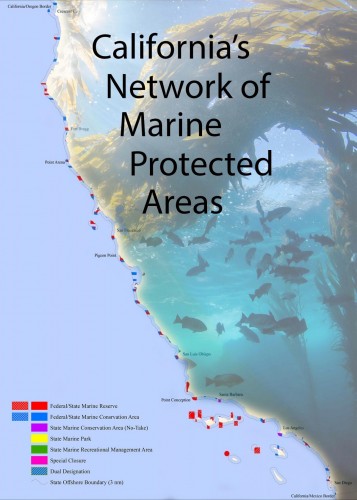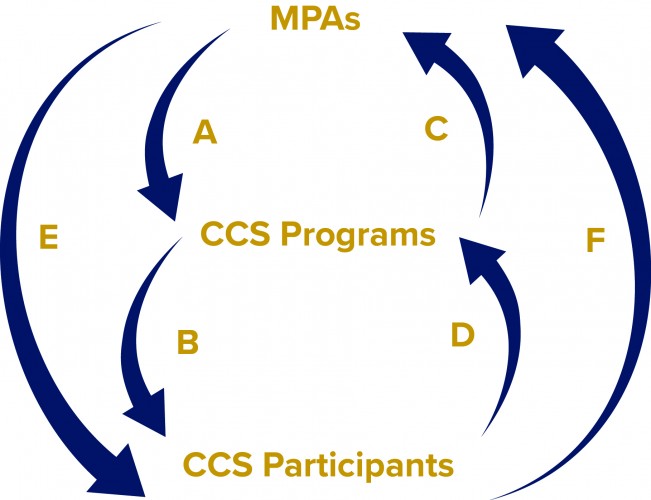Project update: Community and citizen science in California’s Marine Protected Areas
Moving forward with our research and expanding into Oregon's Marine Reserve System
Since submitting our partner report for the Decadal Management Review of MPAs process, we have been working on a second phase of research to dive deeper into some of the dynamics and nuances of the relationships between the MPA Network and community and citizen science (CCS) programs.
How has the implementation of the California MPA Network impacted CCS programs active within MPAs?
 This first research question is
intended to better understand the various ways in which CCS
programs–including those that have been a part of baseline and
long-term monitoring in addition to other programs whose
activities take place within or near MPA boundaries–have been
shaped or influenced by the implementation of the MPA Network.
Examples of the kinds of impacts we’re inquiring about are
participants, methods and protocols, funding and finances,
partnerships, communication, and staffing.
This first research question is
intended to better understand the various ways in which CCS
programs–including those that have been a part of baseline and
long-term monitoring in addition to other programs whose
activities take place within or near MPA boundaries–have been
shaped or influenced by the implementation of the MPA Network.
Examples of the kinds of impacts we’re inquiring about are
participants, methods and protocols, funding and finances,
partnerships, communication, and staffing.
Why do we care about this?
There is plenty of discussion in the CCS literature about how these programs inform decision-making on the part of agencies, NGOs, and others pursuing conservation (for example, here and here). Here in California we have more than a decade of a policy – the Marine Life Protection Act – that has supported a wide variety of CCS programs. So have those programs responded to, evolved, and aligned with the priorities and requirements of that policy? Answering this question could help to think about future implementation of the MLPA. It could also help us think about the ways that conservation professionals can build capacity for CCS through their implementation of broader policies and initiatives.
How does closing “feedback loops” impact CCS programs and participants active within MPAs?
The second research question aims to examine “feedback loops,” which we are defining as the various channels and methods by which information and feedback are shared among and between the MPA Network, CCS programs, and CCS participants.
Why do we care about this?
 Playing integral roles in a variety
of complex social-ecological systems, both CCS and conservation
management involve many different feedback loops among and
between different stakeholders, including users and collectors of
monitoring data. Some
CCS literature has shown that in order for CCS participants
to remain interested and committed to their programs, it is
important for program leaders and partners, like MPA managers, to
provide feedback directly to participants about the data and
results associated with their efforts. Additionally, producing,
documenting, and communicating tangible environmental benefits
for and to communities and community members (along with
communicating these to project partners) have been identified as
elements of effective and equitable marine conservation
management practices (as described
here). Further understanding of this research question will
illuminate opportunities to strengthen communications and “close”
feedback loops in order for MPA management, CCS program leaders,
and CCS participants to all be on the same page in terms of how
CCS data are used to inform and contribute to the MPA
Network.
Playing integral roles in a variety
of complex social-ecological systems, both CCS and conservation
management involve many different feedback loops among and
between different stakeholders, including users and collectors of
monitoring data. Some
CCS literature has shown that in order for CCS participants
to remain interested and committed to their programs, it is
important for program leaders and partners, like MPA managers, to
provide feedback directly to participants about the data and
results associated with their efforts. Additionally, producing,
documenting, and communicating tangible environmental benefits
for and to communities and community members (along with
communicating these to project partners) have been identified as
elements of effective and equitable marine conservation
management practices (as described
here). Further understanding of this research question will
illuminate opportunities to strengthen communications and “close”
feedback loops in order for MPA management, CCS program leaders,
and CCS participants to all be on the same page in terms of how
CCS data are used to inform and contribute to the MPA
Network.
Sources of Data
To address these questions we are gathering data via surveys and multiple series of interviews. Most recently our research activities have included conducting interviews with members of the MPA State Leadership Team. These individuals represent state and federal agencies, philanthropic organizations, conservation organizations, and Tribal communities. We have also concluded a survey that was distributed to a variety of CCS program leaders, and will soon be conducting another round of interviews with these individuals followed by interviews with participants from some of those programs.
Examining Marine Reserves in Oregon
In addition to these activities, we have also begun looking at the role and impacts of CCS programs along the Oregon coast that are active within the Oregon Department of Fish and Wildlife’s network of marine reserves. Beginning with two pilot reserves in 2009 and later increasing to a total of five, Oregon’s Marine Reserves were established to conserve marine habitats and biodiversity and also benefit scientific research and local communities. We are excited to learn from this very different context. While many of the conservation goals of Oregon’s reserves are aligned with those of the MLPA in California, implementation of this smaller network has looked quite different, which we think has important implications for the role of CCS.









